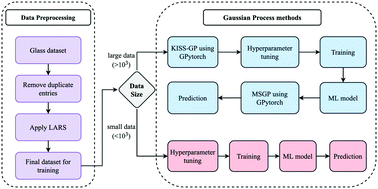Scalable Gaussian processes for predicting the optical, physical, thermal, and mechanical properties of inorganic glasses with large datasets†
Abstract
Among machine learning approaches, Gaussian process regression (GPR) is an extremely useful technique to predict composition–property relationships in glasses. The GPR's main advantage over other machine learning methods is its inherent ability to provide the standard deviation of the predictions. However, the method remains restricted to small datasets due to the substantial computational cost associated with it. Herein, using a scalable GPR algorithm, namely, kernel interpolation for scalable structured Gaussian processes (KISS-GP) along with massively scalable GP (MSGP), we develop composition–property models for inorganic glasses. The models are based on a large dataset with more than 100 000 glass compositions, 37 components, and nine crucial properties: density, Young's, shear, bulk moduli, thermal expansion coefficient, Vickers’ hardness, refractive index, glass transition temperature, and liquidus temperature. We show that the models developed here are superior to the state-of-the-art machine learning models. We also demonstrate that the GPR models can reasonably capture the underlying composition-dependent physics, even in the regions where there are very few training data. Finally, to accelerate glass design, the models developed here are shared publicly as part of a package, namely, Python for Glass Genomics (PyGGi, see: http://pyggi.iitd.ac.in).



 Please wait while we load your content...
Please wait while we load your content...